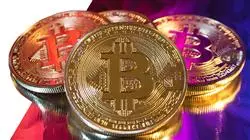University certificate
The world's largest faculty of video games”
Introduction to the Program
Be the future of video games thanks to the opportunities that will open up for you by mastering Blockchain, NFT and Crypto-Gaming with this program"

The influence of the Blockchain and the new virtual economies around Cryptocurrencies, NFT and other assets is already making itself felt in almost every sector. So much so that even Facebook has changed its name to Meta to reflect a safe and reliable future bet on the Metaverse. Video games are no stranger to these changes and large companies are beginning to show increasing interest in an area with a bright future.
Gamified systems such as Alien Worlds, R-Planet or Axie Infinity are just a sample of the potential and attraction that these video games generate for people all over the world. The gaming professional who has mastered the cryptocurrency market, NFT, Metaverse and Blockchain systems will have the necessary knowledge to lead the big titles of the future or even create their own in an environment of exceptional entrepreneurship.
It is precisely with this motivation that this Masters Degree from TECH was created, in which the most advanced advances, tools and theory on Crypto-Gaming are gathered. A panel of professionals with experience in Blockchain projects and gamified economies has developed 10 modules of complete knowledge with which to study in depth gamified economic variables, cryptocurrency analysis, NFT, DeFi, Blockchain and many more essential fields for any video game professional who wants to specialize.
In addition, the student has the advantage of being able to distribute the teaching load as he/she wishes. TECH has eliminated both classroom classes and fixed schedules, providing total flexibility to combine this program with any type of demanding activity, whether at a personal or professional level. The contents can be downloaded from the virtual classroom to any device with an internet connection, allowing you to study them from the comfort of your tablet, computer or even smartphone of your choice.
All the didactic material to which you will have access will serve as a reference guide in your Crypto-Gaming projects, whether they are of your own initiative or in one of the big gaming companies”
This Masters Degree in Crypto-Gaming and Blockchain Economics for Video Games contains the most complete and up-to-date educational program on the market. Its most notable features are:
- The development of case studies presented by experts in cryptocurrencies, Blockchain and video games
- The graphic, schematic, and eminently practical contents with which they are created, provide practical information on the disciplines that are essential for professional practice
- Practical exercises where the self-assessment process can be carried out to improve learning
- Its special emphasis on innovative methodologies
- Theoretical lessons, questions to the expert, debate forums on controversial topics, and individual reflection assignments
- Content that is accessible from any fixed or portable device with an Internet connection
Don't miss out on a unique opportunity to access modern, comprehensive material tailored to both the current challenges of Crypto-Gaming and the imminent opportunities for success”
The program’s teaching staff includes professionals from the sector who contribute their work experience to this training program, as well as renowned specialists from leading societies and prestigious universities.
The multimedia content, developed with the latest educational technology, will provide the professional with situated and contextual learning, i.e., a simulated environment that will provide immersive training programmed to train in real situations.
This program is designed around Problem-Based Learning, whereby the professional must try to solve the different professional practice situations that arise during the academic year. For this purpose, the student will be assisted by an innovative interactive video system created by renowned and experienced experts.
It examines in depth the different strategies and methods to get the most out of Blockchain technology and cryptocurrency mining in gamified environments"

Take a step forward and specialize now in the technologies that will define the future of video games in the coming years"
Why study at TECH?
TECH is the world’s largest online university. With an impressive catalog of more than 14,000 university programs available in 11 languages, it is positioned as a leader in employability, with a 99% job placement rate. In addition, it relies on an enormous faculty of more than 6,000 professors of the highest international renown.

Study at the world's largest online university and guarantee your professional success. The future starts at TECH”
The world’s best online university according to FORBES
The prestigious Forbes magazine, specialized in business and finance, has highlighted TECH as “the world's best online university” This is what they have recently stated in an article in their digital edition in which they echo the success story of this institution, “thanks to the academic offer it provides, the selection of its teaching staff, and an innovative learning method aimed at educating the professionals of the future”
A revolutionary study method, a cutting-edge faculty and a practical focus: the key to TECH's success.
The most complete study plans on the university scene
TECH offers the most complete study plans on the university scene, with syllabuses that cover fundamental concepts and, at the same time, the main scientific advances in their specific scientific areas. In addition, these programs are continuously being updated to guarantee students the academic vanguard and the most in-demand professional skills. In this way, the university's qualifications provide its graduates with a significant advantage to propel their careers to success.
TECH offers the most comprehensive and intensive study plans on the current university scene.
A world-class teaching staff
TECH's teaching staff is made up of more than 6,000 professors with the highest international recognition. Professors, researchers and top executives of multinational companies, including Isaiah Covington, performance coach of the Boston Celtics; Magda Romanska, principal investigator at Harvard MetaLAB; Ignacio Wistumba, chairman of the department of translational molecular pathology at MD Anderson Cancer Center; and D.W. Pine, creative director of TIME magazine, among others.
Internationally renowned experts, specialized in different branches of Health, Technology, Communication and Business, form part of the TECH faculty.
A unique learning method
TECH is the first university to use Relearning in all its programs. It is the best online learning methodology, accredited with international teaching quality certifications, provided by prestigious educational agencies. In addition, this disruptive educational model is complemented with the “Case Method”, thereby setting up a unique online teaching strategy. Innovative teaching resources are also implemented, including detailed videos, infographics and interactive summaries.
TECH combines Relearning and the Case Method in all its university programs to guarantee excellent theoretical and practical learning, studying whenever and wherever you want.
The world's largest online university
TECH is the world’s largest online university. We are the largest educational institution, with the best and widest online educational catalog, one hundred percent online and covering the vast majority of areas of knowledge. We offer a large selection of our own degrees and accredited online undergraduate and postgraduate degrees. In total, more than 14,000 university degrees, in eleven different languages, make us the largest educational largest in the world.
TECH has the world's most extensive catalog of academic and official programs, available in more than 11 languages.
Google Premier Partner
The American technology giant has awarded TECH the Google Google Premier Partner badge. This award, which is only available to 3% of the world's companies, highlights the efficient, flexible and tailored experience that this university provides to students. The recognition as a Google Premier Partner not only accredits the maximum rigor, performance and investment in TECH's digital infrastructures, but also places this university as one of the world's leading technology companies.
Google has positioned TECH in the top 3% of the world's most important technology companies by awarding it its Google Premier Partner badge.
The official online university of the NBA
TECH is the official online university of the NBA. Thanks to our agreement with the biggest league in basketball, we offer our students exclusive university programs, as well as a wide variety of educational resources focused on the business of the league and other areas of the sports industry. Each program is made up of a uniquely designed syllabus and features exceptional guest hosts: professionals with a distinguished sports background who will offer their expertise on the most relevant topics.
TECH has been selected by the NBA, the world's top basketball league, as its official online university.
The top-rated university by its students
Students have positioned TECH as the world's top-rated university on the main review websites, with a highest rating of 4.9 out of 5, obtained from more than 1,000 reviews. These results consolidate TECH as the benchmark university institution at an international level, reflecting the excellence and positive impact of its educational model.” reflecting the excellence and positive impact of its educational model.”
TECH is the world’s top-rated university by its students.
Leaders in employability
TECH has managed to become the leading university in employability. 99% of its students obtain jobs in the academic field they have studied, within one year of completing any of the university's programs. A similar number achieve immediate career enhancement. All this thanks to a study methodology that bases its effectiveness on the acquisition of practical skills, which are absolutely necessary for professional development.
99% of TECH graduates find a job within a year of completing their studies.
Master's Degree in Crypto-Gaming and Blockchain Economy for Videogames
The Blockchain and new online economies, such as cryptocurrencies and NFTs, are having a great impact on the video game sector. Thus, successful titles such as Alien Worlds, R-Planet or Axie Infinity highlight the great potential and attractiveness of cryptovideogames worldwide, offering excellent job prospects for experts in this field. In such line, the TECH Master's Degree in Crypto-Gaming and Blockchain Economics for Video Games has been designed in order to gather the most cutting-edge advances, tools and theories on the subject, thus boosting your professional development in this area.
Learn without the need to attend classroom classes
The Master's Degree in Crypto-Gaming and Blockchain Economics for Video Games is an excellent tool to increase your knowledge in this area. Throughout the course, you will delve into gamified economic variables, cryptocurrency analysis and the ins and outs of NFTs, decentralized finance and Blockchain. Thanks to this, you will significantly expand your skills in this area, with the advantage of being able to distribute the course load yourself as you wish due to the 100% online teaching methodology of this program.







